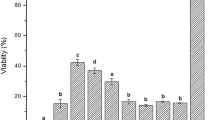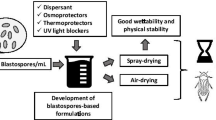Abstract
The present work focuses on the assessment and comparison of three different formulation technologies and the effect of protectants on cell viability, storage stability and antagonistic activity of the biocontrol agent Bacillus amyloliquefaciens CPA-8. Cultures were concentrated with different protective substances such as MgSO4, sucrose and skimmed milk (SM) and subjected to liquid formulation, freeze-drying and fluid-bed spray-drying. Results showed that CPA-8 freeze-dried cells without protectants or amended with SM suffered the highest losses in cell viability (0.41−0.48 log). Moreover, the cell viability of the tested freeze-dried products decreased after four months of storage at both tested temperatures (4 and 22 °C). Otherwise, liquid and fluid-bed spray-dried products were stable for four months at 4 °C and for 12 months at 22, 4 and −20 °C, respectively, and no effect of the protectants was observed. The most suitable CPA-8 products were then tested against Monilinia laxa and M. fructicola in artificially wounded nectarines and in all cases the antagonistic activity was maintained similar to fresh cells. The efficacy results revealed that the formulation process did not affect the biocontrol potential of CPA-8. This work led us to conclude that effective formulations with final concentrations ranging from 1.93 × 109–2.98 × 109 CFU ml−1 and from 4.76 × 109–1.03 × 1010 CFU g−1 were obtained for liquid and dried products, respectively. Additionally, the suitability of the fluid-bed spray drying technology should be taken into account to develop a stable and effective CPA-8 product for practical applications to control brown rot in stone fruit.




Similar content being viewed by others
References
Abadias M, Teixidó N, Usall J, Benabarre A, Viñas I (2001) Viability, efficacy, and storage stability of freeze-dried biocontrol agent Candida sake using different protective and rehydration media. J Food Prot 64: 856–861
Abadias M, Teixidó N, Usall J, Viñas I (2003) Optimization of growth conditions of the postharvest biocontrol agent Candida sake CPA in a lab-scale fermenter. J Appl Microbiol 95: 301–309
Abadias M, Teixidó N, Usall J, Solsona C, Viñas I (2005) Survival of the postharvest biocontrol yeast Candida sake CPA-1 after dehydration by spray-drying. Biocontrol Sci Technol 15: 835–846
Casals C, Teixidó N, Viñas I, Silvera E, Lamarca N, Usall J (2010) Combination of hot water, Bacillus subtilis CPA-8 and sodium bicarbonate treatments to control postharvest brown rot on peaches and nectarines. Eur J Plant Pathol 128: 51–63
Casals C, Elmer PAG, Viñas I, Teixidó N, Sisquella M, Usall J (2012) The combination of curing with either chitosan or Bacillus subtilis CPA-8 to control brown rot infections caused by Monilinia fructicola. Postharvest Biol Technol 64: 126–132
Champagne CP, Gardner N, Brochu E, Beaulieu Y (1991) The freeze-drying of lactic acid bacteria: a review. Can Inst Food Sci Technol 24: 118–128
Costa E, Usall J, Teixidó N, García N, Viñas I (2000). Effect of protective agents, rehydration media and initial cell concentration on viability of Pantoea agglomerans strain CPA-2 subjected to freeze-drying. J Appl Microbiol 89: 793–800
Droby S, Wisniewski M, Macarisin D, Wilson C (2009). Twenty years of postharvest biocontrol research: is it time for a new paradigm? Postharvest Biol Technol 52: 137–145
Gotor-Vila A., Teixidó N, Usall J, Dashevskaya S, Torres R (2016). Development of a SCAR marker and a strain-specific genomic marker for the detection of the biocontrol agent strain CPA-8 Bacillus amyloliquefaciens (formerly B. subtilis). Ann Appl Biol 169: 248–256
Hubalek Z (2003) Protectants used in the cryopreservation of microorganisms. Cryobiology 46: 205–229
Janisiewicz WJ, Korsten L (2002) Biological control of postharvest diseases of fruits. Annu Rev Phytopathol 40: 411–441
Larena I, Torres R, De Cal A, Liñán M, Melgarejo P, Domenichini P, Bellini A, Mandrin JF, Lichou J, Ochoa de Eribe X, Usall J (2005) Biological control of postharvest brown rot (Monilinia spp.) of peaches by field applications of Epicoccum nigrum. Biol Control 32: 305–310
Li BQ, Tian SP (2007) Effect of intracellular trehalose in Cryptococcus laurentii and exogenous lyoprotectants on its viability and biocontrol efficacy on Penicillium expansum in apple fruit. Lett Appl Microbiol 44: 437–442
Mari M, Torres R, Casalini L, Lamarca N, Mandrin JF, Lichou J, Larena I, De Cal MA, Melgarejo P, Usall J (2007) Control of post-harvest brown rot on nectarine by Epicoccum nigrum and physico-chemical treatments. J Sci Food Agric 87: 1271–1277
Mari M, Di Francesco A, Bertolini P (2014) Control of fruit postharvest diseases: old issues and innovative approaches. Stewart Postharvest Review 1(1): 1–4
Melin P, Hakansson S, Schnurer J (2007) Optimisation and comparison of liquid and dry formulations of the biocontrol yeast Pichia anomala J121. Appl Microbiol Biotechnol 73: 1008–1016
Melin P, Schnurer J, Hakansson S (2011) Formulation and stabilisation of the biocontrol yeast Pichia anomala. Anton Leeuw 99: 107–112
Navarta LG, Calvo J, Calvente V, Benuzzi D, Sanz MI (2011). Freezing and freeze-drying of the bacterium Rahnella aquatilis BNM 0523: study of protecting agents, rehydration media and freezing temperatures. Lett Appl Microbiol 53: 565–571
Nicholson WL, Munakata N, Horneck G, Melosh HJ, Setlow P (2000). Resistance of Bacillus endospores to extreme terrestrial and extraterrestrial environments. Microbiol Mol Biol Rev 64: 548–572
Nunes C (2012) Biological control of postharvest diseases of fruit. Eur J Plant Pathol 133: 181–196
Sabuquillo P, De Cal A, Melgarejo P (2010) Development of a dried Penicillium oxalicum conidial formulation for use as a biological agent against Fusarium wilt of tomato: selection of optimal additives and storage conditions for maintaining conidial viability. Biol Control 54: 221–229
Sharma RR, Singh D, Singh R (2009) Biological control of postharvest diseases of fruits and vegetables by microbial antagonists: a review. Biol Control 50: 205–221
Srivastava S, Mishra G (2010) Fluid bed technology: overview and parameters for process selection. Int J Pharma Sci Drug Res 2 (4): 236–246
Strasser S, Neureiter M, Geppl M, Braun R, Danner H (2009) Influence of lyophilization, fluidized bed drying, addition of protectants, and storage on the viability of lactic acid bacteria. J Appl Microbiol 107: 167–177
Teixidó N, Torres R, Abadias M, Usall J (2011) Biological control of postharvest diseases in fruit and vegetables. In: Lacroix, C., (Ed.), Protective cultures, antimicrobial metabolites and bacteriophages for food and beverage. Woodhead Publishing Limited. Cambridge, pp. 364–402
Usall J, Casals C, Sisquella M, Palou L, De Cal A (2015) Alternative technologies to control postharvest diseases of stone fruits. Stewart Postharvest Rev 11(4): 1–6
Yánez-Mendizábal V, Viñas I, Usall J, Cañamás T, Teixidó N (2012a) Endospore production allows using spray-drying as a possible formulation system of the biocontrol agent Bacillus subtilis CPA-8. Biotechnol Lett 34: 729–735
Yánez-Mendizábal V, Viñas I, Usall J, Torres R, Solsona C, Abadias M, Teixidó N (2012b) Formulation development of the biocontrol agent Bacillus subtilis strain CPA-8 by spray-drying. J Appl Microbiol 112: 954–965
Yánez-Mendizábal V, Viñas I, Usall J, Torres R, Solsona C, Teixidó N (2012c) Production of the postharvest biocontrol agent Bacillus subtilis CPA-8 using low cost commercial products and by-products. Biol Control 60: 280–289
Yánez-Mendizábal V, Zeriouh H, Viñas I, Torres R, Usall J, de Vicente A, Pérez-García A, Teixidó N (2012d) Biological control of peach brown rot (Monilinia spp.) by Bacillus subtilis CPA-8 is based on production of fengycin-like lipopeptides. Eur J Plant Pathol 132: 609–619
Zhan Y, Xu Q, Yang MM, Yang HT, Liu HX, Wang YP, Guo JH (2011) Screening of freeze-dried protective agents for the formulation of biocontrol strains, Bacillus cereus AR156, Burkholderia vietnamiensis B418 and Pantoea agglomerans 2Re40. Lett Appl Microbiol 54: 10–17
Acknowledgements
This research was supported by the European project BIOCOMES FP7-612713 and by the Secretaria d’Universitats i Recerca del Departament d’Economia i Coneixement de la Generalitat de Catalunya for the PhD Grant 2014-FI-B00367 (Amparo M. Gotor Vila). The authors also thank CERCA Program (Generalitat de Catalunya).
Author information
Authors and Affiliations
Corresponding author
Ethics declarations
Conflict of interest
The authors declare that they have no conflict of interest.
Additional information
Handling Editor: Fouad Daayf.
Rights and permissions
About this article
Cite this article
Gotor-Vila, A., Usall, J., Torres, R. et al. Formulation of the biocontrol agent Bacillus amyloliquefaciens CPA-8 using different approaches: liquid, freeze-drying and fluid-bed spray-drying. BioControl 62, 545–555 (2017). https://doi.org/10.1007/s10526-017-9802-3
Received:
Accepted:
Published:
Issue Date:
DOI: https://doi.org/10.1007/s10526-017-9802-3




